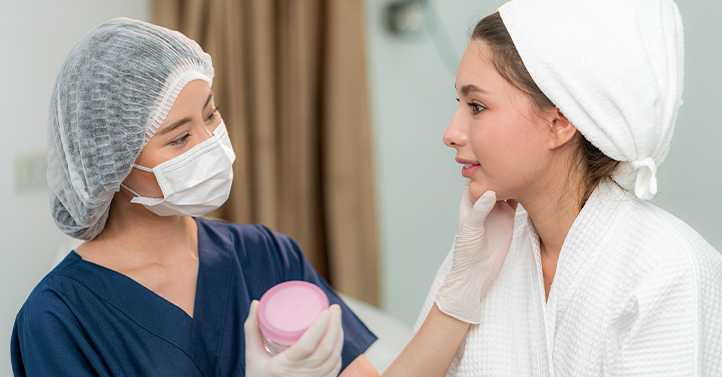The medical care providers channel has been the shining star of the professional skin care market for several years, registering double-digit growth in 2021 to reach $2.3 billion, according to our Medical Dispensing Skin Care: Global Market Brief report. While the COVID-19 pandemic caused physicians around the world to temporarily shutter their doors, opportunities nevertheless arose, resulting in an unprecedented global surge in sales of medical dispensed skin care brands.
Here are five insights on where demand may exist among the more than 60 markets in Europe, Latin America, North America, Asia Pacific, and the Middle East that we cover. These are key areas that marketers must understand in order to identify how they can both compete and avoid costly mistakes.
1. Local, regional, and national brands
Distributors can play a key role in many markets for international and regional brands. They know the ins and outs of the markets and can help a brand navigate through foreign terrain. Leading brands such as ZO, Obagi, and iS Clinical have a distributor network, while SkinCeuticals has an on-the-ground presence in its markets.
Local brands can have a strong presence in important dispensing markets. Such is the case in countries like China and Argentina. This can act as a roadblock to entry into the international markets, where familiarity with a particular market and its nuances may be lacking.
Our reports identify distributors and whether they are distributing multiple brands.
2. Navigating around regulations
An understanding of the regulatory framework for dispensing is critical. There are restrictions in some markets that prevent doctors from dispensing skin care. Such is the case in Argentina, a key aesthetic market for procedures. One way for physicians to navigate around some of these regulations is to open their own pharmacies, which enables them to dispense. Another approach is to bundle products with procedures.
Our reports identify the regulations within a particular region and how physicians can work around them.
3. What matters most
Consumer demands differ from region to region. For example, sun care is the leading product type in demand in Latin America; brands that don’t have a strong portfolio in sun care may not be able to compete.
In addition, some markets are more price-sensitive than others; this can make it difficult for higher- and mid-level-price brands to reach a wider target audience.
Our reports identify product types and skin care concerns by level of importance and potential.
4. Who’s dispensing?
We were very surprised to discover from our research that in several markets, both opportunistic and established, opportunities existed beyond the traditional dispensing physicians — dermatologists and plastic surgeons. For example, in Latin America, aesthetic physicians play a crucial role in providing aesthetic procedures like fillers and Botox, as well as dispensing skin care. In some markets, nurse practitioners are dispensing skin care in their injectable practice.
Our reports identify all important targets for dispensing skin care.
5. What are the key opportunities?
In our Medical Dispensing Skin Care: Global Market Brief report, which covers various global medical dispensing markets, we identify where the key opportunities lie, enabling brands to focus on or plan their business/entry. There are a number of potential markets such as Russia, Nordics, and Australia, among others where marketers may want to concentrate on expanding their presence. Opportunities vary from region to region; e.g., younger physicians represent an opportunity area in some markets, while core physicians such as dermatologists or plastic surgeons represent possibilities in others. Similarly, opportunities may vary from region to region when it comes to key product types and skin concerns. Knowing the difference can be critical.
Our reports identify where these key opportunities lie.
Integrated skin care, an important element
Physicians in the medical dispensing channel focus primarily on offering procedures such as injectables, fillers, lasers, and peels. The strong demand for physician-dispensed skin care products is directly linked to the growing demand for cosmetic procedures, as these physicians often integrate professional skin care products that complement these procedures, as pre– and/or post-procedure care. Several professional brands such as Alastin, SkinCeuticals, ZO, and Obagi either position or offer a dedicated line of pre–/post-procedure care products that can be combined with various cosmetic procedures.
About this blog:
Medical Dispensing Skin Care: 5 Ways to Generate New Demand contains insights from Karen Doskow, Director of Kline’s Beauty & Personal Care practice. Doskow has more than 30 years of experience in the beauty, home care, and related markets. She oversees global and domestic research teams on several flagship reports including Beauty Devices, Cosmetics & Toiletries, Professional Skin Care, and Beauty Retailing. Prior to joining Kline, Doskow worked on the marketing and advertising sides of the business on brands such as Pantene, Chanel, and Avon. She has achieved industry recognition as a marketing expert in beauty and related markets and is a presenter at major conferences; she is frequently quoted as an industry expert in various publications and presents at major beauty-related conferences. Doskow holds a B.S. in public relations from the S.I. Newhouse School of Public Communications at Syracuse University.
Press inquiries:
| Lance Debler |
| Content Marketing Manager |
| Kline & Company |
| +1-973-435-3425 |

